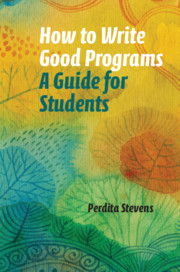Book contents
- Frontmatter
- Contents
- 1 Introduction
- 2 What Are Good Programs?
- 3 How to Get Started
- 4 How to Understand Your Language
- 5 How to Use the Best Tools
- 6 How to Make Sure You Don’t Lose Your Program
- 7 How to Test Your Program
- 8 How to Make Your Program Clear
- 9 How to Debug Your Program
- 10 How to Improve Your Program
- 11 How to Get Help (without Cheating)
- 12 How to Score Well in Coursework
- 13 How to Score Well in a Programming Exam
- 14 How to Choose a Programming Language
- 15 How to Go Beyond This Book
- Bibliography
- Index
5 - How to Use the Best Tools
Published online by Cambridge University Press: 10 July 2020
- Frontmatter
- Contents
- 1 Introduction
- 2 What Are Good Programs?
- 3 How to Get Started
- 4 How to Understand Your Language
- 5 How to Use the Best Tools
- 6 How to Make Sure You Don’t Lose Your Program
- 7 How to Test Your Program
- 8 How to Make Your Program Clear
- 9 How to Debug Your Program
- 10 How to Improve Your Program
- 11 How to Get Help (without Cheating)
- 12 How to Score Well in Coursework
- 13 How to Score Well in a Programming Exam
- 14 How to Choose a Programming Language
- 15 How to Go Beyond This Book
- Bibliography
- Index
Summary
A key choice is where you will build your program: in a basic editor, a more sophisticated editor, or an integrated development environment. This chapter discusses how to make this choice and get the most out of your chosen tool.
- Type
- Chapter
- Information
- How to Write Good ProgramsA Guide for Students, pp. 48 - 54Publisher: Cambridge University PressPrint publication year: 2020

